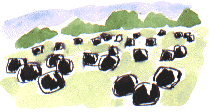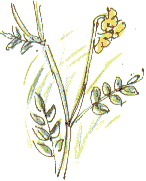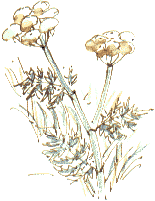Take Another Look
Wild West Yorkshire nature diary, Tuesday 8th June 1999
 THE SHRINK-WRAPPED rolls of silage still lie on the slope. From a distance they look like so many caterpillar droppings, but from the foot of the slope, at the field gate, their black bulk gives them a brooding presence, like standing stones. Perhaps it is because we're used to seeing a herd of cattle in this field that this 'herd' of inanimate objects seems frozen in time. Only a couple of wisps of plastic give any hint of movement.
THE SHRINK-WRAPPED rolls of silage still lie on the slope. From a distance they look like so many caterpillar droppings, but from the foot of the slope, at the field gate, their black bulk gives them a brooding presence, like standing stones. Perhaps it is because we're used to seeing a herd of cattle in this field that this 'herd' of inanimate objects seems frozen in time. Only a couple of wisps of plastic give any hint of movement.
 Pheasant's Eye is the name that immediately springs to mind when I see this flower. Then I remember, from previous summers, that it is Cut-leaved Cranesbill.
Pheasant's Eye is the name that immediately springs to mind when I see this flower. Then I remember, from previous summers, that it is Cut-leaved Cranesbill.
 The advice of the original Collin's Field Guide was 'always take the book to the flower, not the flower to the book.' At this time of year there are new flowers appearing every week, if not every day. Doing a regular walk in the same area is one of the best ways to see them all, and to look at them repeatedly until the particular features of a 'difficult' flower begin to sink in.
The advice of the original Collin's Field Guide was 'always take the book to the flower, not the flower to the book.' At this time of year there are new flowers appearing every week, if not every day. Doing a regular walk in the same area is one of the best ways to see them all, and to look at them repeatedly until the particular features of a 'difficult' flower begin to sink in.
With me, this could take years!
I think of this flower, climbing amongst tall grasses, as Yellow Vetchling, when I check with three of my flower books I realise it isn't, the leaves are wrong. Yellow Vetch then? Or Meadow Vetchling? The best thing is to return and have an even closer look at the arrangement of flowers, the exact shape of the leaves and to check whether it really does have tendrils.
 I'm happier with my identification of this tall umbellifer growing from the edge of the canal as Hemlock Water Dropwort. As the name suggests it is completely poisonous.
I'm happier with my identification of this tall umbellifer growing from the edge of the canal as Hemlock Water Dropwort. As the name suggests it is completely poisonous.
An update on the 'Killer Coots' mentioned a week ago. Since then we've seen no more aggression, there is a pair with three young, perhaps the same family, and three older young on their own. Let's hope it was all resolved peacefully
Richard Bell,
wildlife illustrator
E-mail; 'richard@daelnet.co.uk'



 Next day
Previous day
Nature Diary
Wild West Yorkshire home page
Next day
Previous day
Nature Diary
Wild West Yorkshire home page
|
 THE SHRINK-WRAPPED rolls of silage still lie on the slope. From a distance they look like so many caterpillar droppings, but from the foot of the slope, at the field gate, their black bulk gives them a brooding presence, like standing stones. Perhaps it is because we're used to seeing a herd of cattle in this field that this 'herd' of inanimate objects seems frozen in time. Only a couple of wisps of plastic give any hint of movement.
THE SHRINK-WRAPPED rolls of silage still lie on the slope. From a distance they look like so many caterpillar droppings, but from the foot of the slope, at the field gate, their black bulk gives them a brooding presence, like standing stones. Perhaps it is because we're used to seeing a herd of cattle in this field that this 'herd' of inanimate objects seems frozen in time. Only a couple of wisps of plastic give any hint of movement. Pheasant's Eye is the name that immediately springs to mind when I see this flower. Then I remember, from previous summers, that it is Cut-leaved Cranesbill.
Pheasant's Eye is the name that immediately springs to mind when I see this flower. Then I remember, from previous summers, that it is Cut-leaved Cranesbill. The advice of the original Collin's Field Guide was 'always take the book to the flower, not the flower to the book.' At this time of year there are new flowers appearing every week, if not every day. Doing a regular walk in the same area is one of the best ways to see them all, and to look at them repeatedly until the particular features of a 'difficult' flower begin to sink in.
The advice of the original Collin's Field Guide was 'always take the book to the flower, not the flower to the book.' At this time of year there are new flowers appearing every week, if not every day. Doing a regular walk in the same area is one of the best ways to see them all, and to look at them repeatedly until the particular features of a 'difficult' flower begin to sink in. I'm happier with my identification of this tall umbellifer growing from the edge of the canal as Hemlock Water Dropwort. As the name suggests it is completely poisonous.
I'm happier with my identification of this tall umbellifer growing from the edge of the canal as Hemlock Water Dropwort. As the name suggests it is completely poisonous.